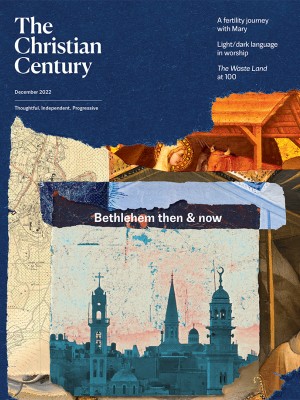After Pope Francis’s visit, Indigenous people in Canada reflect on trauma, healing
In July, Pope Francis made a widely publicized “pilgrimage of penance” to Canada. Over six days, Francis met with Indigenous people across the country in order to listen and to apologize for the Catholic Church’s role in running Canada’s residential schools—a system that removed 150,000 children from their families and led to loss of Indigenous identity, language, and culture.
“I want to tell you how very sorry I am and to ask for forgiveness for the evil perpetrated by not a few Catholics who contributed to the policies of cultural assimilation and enfranchisement in those schools,” Francis said on the final stop of the tour.
Read our latest issue or browse back issues.
Francis’s visit was immediately met with mixed reviews, and in the months since, Indigenous people have had time to further process and reflect on what his apology meant—or didn’t mean—to them.
“There are people who are happy with the visit, and to some, it doesn’t matter so much,” Riley Yesno told the CENTURY. The activist and member of the Eabametoong First Nation was disappointed that Francis made no mention of returning stolen Indigenous artifacts during this tour.
“I care about action beyond symbolism,” said Yesno. But she also knows that for others, hearing their lived experience finally acknowledged was “monumental” and a pathway to healing.
Amanda Hill, a descendant of survivors of the residential school system, saw Francis’s apology as a significant sign of solidarity with Indigenous people.
“They wanted to get rid of us and our culture, but as a spiritual figure, his visit has put us back on the map as important people who should be spiritually recognized and treated equally,” she said.
Hill, a practicing Catholic, said that in her opinion, those who won’t accept Francis’s apology do not understand what it means.
“There are a lot of hardened and unforgiving hearts, and only the spirit can move them,” she said. “For me, the visit was to right historical wrongs and to show us the humanity we deserve, and the church needs to continue this way moving forward.”
The residential school system, established in the 1800s, was designed to convert Indigenous children and assimilate them into White Canadian society. Many children were never returned to their families, and many were sexually, physically, and psychologically abused by priests and other administrators at the schools. More than 3,000 children died.
The Canadian government has been trying to move forward since 2007, when it began implementing the Indian Residential Schools Settlement Agreement—the largest class-action settlement in Canadian history. One step was to create a truth and reconciliation commission, which operated from 2007 to 2015.
Then, in 2021, the Canadian government declared September 30 the National Day of Truth and Reconciliation, a federal holiday intended to honor the victims and survivors of the residential schools. In addition to memorials and seminars, Canadians are encouraged to wear orange shirts—a symbol that every child matters.
During this year’s events, Yesno spoke at a ceremony held at the University of Toronto, where she is currently working toward a PhD in Canadian politics. “Today is to remember the role of the church and the harm caused to victims,” she told the gathering.
But increasingly, younger people from Canada’s Indigenous nations have been asking for more than remembrance. Yesno told the century that it’s young people who are leading the call for reparation from the church. And it seems to be working.
In September 2021, Canada’s Catholic bishops agreed to pay $30 million over a five-year period to support healing and reconciliation initiatives for residential school survivors and their communities. Earlier that year, the Jesuit Forum for Social Faith and Justice published Listening to Indigenous Voices: A Dialogue Guide on Justice and Right Relationships.
Trevor Scott, a Jesuit priest and the facilitation coordinator for the Jesuit Forum, helped produce the guide. It’s important, he said, that White Canadians also understand the colonial legacy that traumatized so many Indigenous communities.
“In order to heal and be reconciled, we need to know their history and experiences,” he said, “and not just in our heads, but in our hearts as well—to deepen our sense of what they have faced for centuries.”
As discussions around healing continue in the aftermath of Francis’s visit, one thing the Catholic Church will have to continue to grapple with is the way its participation in the residential school system has pushed Indigenous people away from the church.
Hill said she knows of some Indigenous people who would be willing to come back to the Catholic Church if there were adequate opportunities for real healing. Specifically, she thinks there need to be more gatherings where people can talk freely about their experiences.
Yesno said she left the church after college in order to give herself access to other parts of her culture. She now practices her Indigenous spirituality, which she said brings her peace and deeper connection.
“I feel I’m part of something bigger than myself,” she said. “Religion and faith are things that are supposed to bring you peace and teach you how to be good members of the community. I never felt that the Catholic Church did that for me.”





